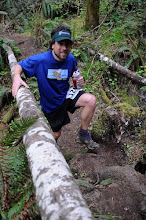Question: What is the chance that any given starter will actually finish Western States 100 miler in June?
Answer: 66%. A priori, those are the odds of any randomly selected starter actually finishing Western States 100m this June. Presumably the chance of finishing might be even lower for people who are attempting their first 100 miler, such as myself. Since fitness doesn’t accrue from training alone (it requires some good rest after) I decided to take a look at some of the historical data from the Western States website.
Finishing rate versus year.
Question: What determines the finishing rate of the race on any give year?
Answer: According the Western States participant guide one of the most commonly cited reasons for not finishing the race is due to the heat. There are some strategies that one might do to mitigate this, but I’ll address those in a future post in May or so when I actually start doing them. For now I’d like to focus on things that are totally out of my control. It feels good. Trust me.
Answer: According the Western States participant guide one of the most commonly cited reasons for not finishing the race is due to the heat. There are some strategies that one might do to mitigate this, but I’ll address those in a future post in May or so when I actually start doing them. For now I’d like to focus on things that are totally out of my control. It feels good. Trust me.
High temperature in Sacramento on race day versus year.
The finishing percentage at this race actually depends quite a bit on the weather (as an aside there has also been a fairly significant secular increase in the percentage of finishers with respect to year, thus I didn’t look at years prior to 1989 for this analysis). The mean high temperature on race day at the Sacramento Airport, which is fairly close to Auburn and has longer and more consistent weather records than Auburn, is 89 F. The correlation between finishing percentage and high temperature on race day is fairly high, with a slope of approximately 5% per 10F. That is, the chance that any given runner will finish given the climatological high of 89 F is 66% (and no, despite the fact that I'm getting a PhD in Atmospheric Sciences I did not look for a secular increase in high temperature on race day with respect to race day). If the high temperature is 10F warmer or cooler than the climatological mean high of 89 F, the odds of any runner finishing go up or down 5% from the historical average of 66%.
Correlation between finishing rate and high temperature on race day.
There’s quite a bit of scatter in the data, but the finishing rate from the last few years generally follow the trend. 2006 and 2009 were hot and had a low completion rate, while the highest completion rate as of late was in relatively cool 2005.
Finishing rate and high temperature for the last few years
Interestingly 2006 and 2009 show a large number of drops from Last Chance AS to Cal2/Peachstone AS, miles 42 to 70 (labeled below as aid stations #8 and #14 respectively. Perhaps this depends quite a bit on the fact that this part of the course is tackled by many at the hottest part of the day, as well the cumulative accrued mileage, and the significant hills to dealt with.
Number of runners left versus aid station for the last few races
Elevation profile of the course from the WS website (note the profile goes from right to left)
Now 66% might sound a little low. Non-running friends of mine might be thinking ‘Yes Craig but you train a lot and you’re fit’ (running friends of mine might be thinking something totally different). Well yes … but I have no reason to believe that my training over the next few months will be any better or worse than anybody else out there, except for the really fast people, but since their training is so much different than a first timers there is little use for comparison. Naturally I’ll be running my first one to finish, not for time.
So what does it take to run 100 miles? I have no idea. I’ve done a 50 miler before. It wasn’t so bad, but I’m not sure that’s indicative of me having any sort of clue whatsoever about what I’ve signed myself up for, or how to go about training for it. The internets have been quite useful in forming a training plan, so have the local runners, some of whom are absolute fountains of knowledge. In retrospect this might be a classic case of ‘talking about running a 100 miler is a lot more fun/easy than actually training for and running 100 miles’. To be fair, I didn’t expect to attempt to run a 100 m this year. The plan was to run a 100 km and next year get into and run Western States, since the lottery system for Western States favors those who didn’t get selected the year before. Fate intervened. I lucked out and randomly got selected for entry. Given that I’ve never actually failed at trying to run this distance, there is no reason to believe that I can’t do it, right?














I have done the same plot a few year back. Note that the top three "outlier" points in "Correlation between finishing rate and high temperature on race day." are the year where they by-pass Duncan Canyon.
ReplyDeleteI hadn't realized that there has been so many course changes. Hopefully this years runners will have a nice course.
ReplyDelete